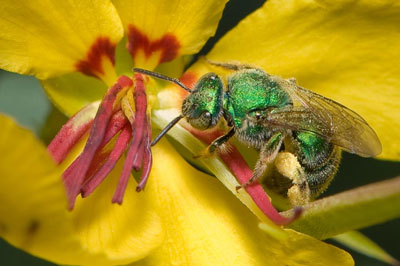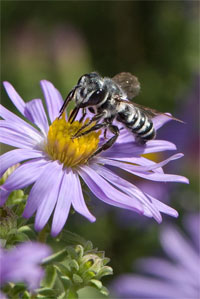Wild About Texas – March, 2009

This metallic green bee, one of more than 700 bee species native to Texas, is a sweat bee (Halicitidae). All photos by Bruce Leander.
Native Bees
Meet some tireless Texas pollinators!

This black and white bee is a leaf cutter bee (Megachilidae).
Spring has arrived in many parts of Texas, which means our gardens soon will be bursting with the first flowers of the season. As you’re out tending your plants and garden beds, take a moment to notice the visitors that are starting to appear at the flowers. Chances are many of them are our native bees. Most people are familiar with honeybees (Apis millifera), which hail from Europe, but few realize that we have more than 700 bee species native to the Lone Star State alone. There are more than 3,500 species in the U.S., and we have reports of 20,000 to 30,000 species worldwide.
Native bees are very efficient pollinators, much more so than honeybees, in fact. The advantage that honeybees have — and why so many commercial farms use them — is their sheer numbers. They are able to go out and pollinate as a colony, whereas the native bees, which are also known as solitary bees, pollinate individually. However, many native species are active earlier in the spring than honeybees, they fly more rapidly, therefore visiting more plants, and both males and females pollinate, rather than just the female of the honeybees. Because they are such great pollinators, they are naturally a gardener’s friend. Without their help, and the help of other beneficial insects, of course, our vegetable gardens wouldn’t be able produce the bounty that feeds our families, and our flower gardens would be less prolific.
Like many plant and animal species today, the bees’ numbers are starting to decline. One major cause is habitat loss. Unlike social honeybees that build large colonies and live together, solitary bees seek out more private accommodations. You can find evidence of their nests in dead wood, pithy stems, pre-existing cavities, and in some cases, underground. Create bee habitat in your own backyard or garden by following a few simple steps. First, be sure to provide bees with a full palette of plants that flower at varying times throughout the growing season. This will ensure that they have food year-round — and you will benefit, too, from a garden full of color. Second, for bees that like to nest below ground, leave a sunny area of soil undisturbed, and for those that prefer to nest in wood and open cavities, leave a small pile of branches and hollow stems for them to move into. You can also build your own nesting houses by drilling holes into blocks of untreated wood and positioning them around your property. Third, bees, like all living creatures, need a source of water. A nearby birdbath or pond with a shallow landing area is helpful, but whatever method you use to water your garden should be sufficient.
Relatively little is known about these private creatures. As gardeners who depend on the ecosystem service they provide, we need to raise our awareness of them, and help to conserve their habitat wherever possible. They are our companions in the gardens, and when provided with a little food and shelter, they will work tirelessly for us and our gardens will be all the better for it!
For information about Texas native plants, visit the Wildflower Center’s website at: www.wildflower.org.
About the author: Deryn Davidson is a horticulturist at the Lady Bird Johnson Wildflower Center in Austin.

